USS Franklin may refer to:
Three vessels of the United States Navy or United States Coast Guard have been named USS Onondaga, after Onondaga Lake and Onondaga County, New York.
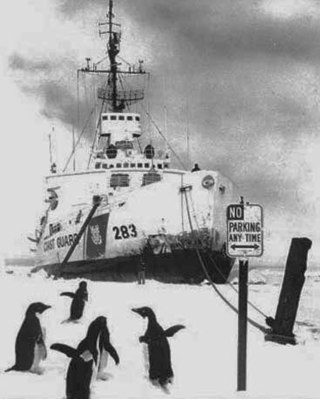
USS Burton Island (AG-88) was a United States Navy Wind-class icebreaker that was later recommissioned in the United States Coast Guard as the USCGC Burton Island (WAGB-283). She was named after an island near the coast of Delaware.

The Wind-class icebreakers were a line of diesel electric-powered icebreakers in service with the United States Navy, United States Coast Guard, Royal Canadian Navy, Canadian Coast Guard and Soviet Navy from 1944 through the late 1970s. They were very effective ships: all except Eastwind served at least thirty years, and Northwind served in the USCG continuously for forty-four years. Considered the most technologically advanced icebreakers in the world when first built, the Wind-class icebreakers were also heavily armed; the first operator of the class was the United States Coast Guard, which used the vessels for much-needed coastal patrol off Greenland during World War II. Three of the vessels of the class, Westwind, Southwind, and the first Northwind all went on to serve temporarily for the Soviet Union under the Lend-Lease program, while two others were built for the United States Navy and another was built for the Royal Canadian Navy; all eight vessels were eventually transferred to the United States Coast Guard and the Canadian Coast Guard.

The second USS Mackinac (AVP-13) was a United States Navy Barnegat-class small seaplane tender in commission from 1942 to 1947 that saw service during World War II. After the war, she was in commission in the United States Coast Guard from 1949 to 1967 as the cutter USCGC Mackinac (WAVP-371), later WHEC-371, the second ship of the Coast Guard or its predecessor, the United States Revenue Cutter Service, to bear the name.
USS Barricade (ACM-3) was a Chimo-class minelayer in the United States Navy during World War II.

USS Bering Strait (AVP-34) was a United States Navy Barnegat-class small seaplane tender in commission from 1944 to 1946. She tended seaplanes during World War II in the Pacific in combat areas and earned three battle stars by war's end.

The second USS Suwannee and third USS Mayflower was a United States Lighthouse Board, and later United States Lighthouse Service, lighthouse tender transferred to the United States Navy in 1898 for service as an auxiliary cruiser during the Spanish–American War and from 1917 to 1919 for service as a patrol vessel during World War I. She also served the Lighthouse Board and in the Lighthouse Service as USLHT Mayflower from 1897 to 1898, from 1898 to 1917, and from 1919 to 1939, and in the United States Coast Guard as the first USCGC Mayflower (WAGL-236) in 1939 and from 1940 to 1943 and as USCGC Hydrangea (WAGL-236) from 1943 to 1945.
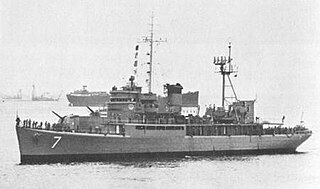
BRP Andrés Bonifacio (PF-7) was a Philippine Navy frigate in commission from 1976 to 1985. She was one of six ex-United States Navy Barnegat-class small seaplane tenders/ex-United States Coast Guard Casco-class high endurance cutters received from the United States after the Vietnam War, two of which were acquired to supply spare parts for the other four. Andrés Bonifacio was considered the lead ship of her class in the Philippine Navy, and she and her three commissioned sister ships were the largest Philippine Navy combat ships of their time.

USS Chincoteague (AVP-24) was a United States Navy seaplane tender in commission from 1943 to 1946 that saw service in the Pacific during World War II. After the war, she was in commission in the United States Coast Guard as the cutter USCGC Chincoteague (WAVP-375), later WHEC-375, from 1949 to 1972. She was transferred to South Vietnam in 1972 and was commissioned into service with the Republic of Vietnam Navy as the frigate RVNS Lý Thường Kiệt (HQ-16), seeing combat in the Battle of the Paracel Islands in 1974. When South Vietnam collapsed at the conclusion of the Vietnam War in 1975, she fled to the Philippines, where she was commissioned into the Philippine Navy, serving as the frigate RPSAndrés Bonifacio (PF-7) from 1976 to 1985.
The BRP Francisco Dagohoy (PF-10) was an Andrés Bonifacio-class frigate of the Philippine Navy that served from 1979 to 1985. She was one of six ex-United States Navy Barnegat-class small seaplane tenders and ex-United States Coast Guard Casco-class high endurance cutters received from the United States after the Vietnam War, two of which were cannibalized for spare parts without entering service. She and her other three sister ships were the largest Philippine Navy ships of their time.

USS Castle Rock (AVP-35) was a United States Navy Barnegat-class small seaplane tender in commission from 1944 to 1946 which saw service in the late months of World War II. After the war, she was in commission in the United States Coast Guard as the Coast Guard cutter USCGC Castle Rock (WAVP-383), later WHEC-383, from 1948 to 1971, seeing service in the Vietnam War during her Coast Guard career. Transferred to South Vietnam in 1971, she served in the Republic of Vietnam Navy as the frigate RVNS Trần Bình Trọng (HQ-05) and fought in the Battle of the Paracel Islands in 1974. When South Vietnam collapsed at the end of the Vietnam War in 1975, Trần Bình Trọng fled to the Philippines, where she served in the Philippine Navy from 1979 to 1985 as the frigate RPSFrancisco Dagohoy (PF-10).
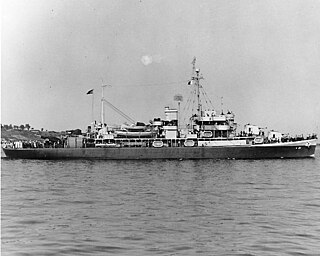
USS Humboldt (AVP-21) was a United States Navy Barnegat-class small seaplane tender in commission from 1941 to 1947 that served in the Atlantic during World War II. She was briefly reclassified as a miscellaneous auxiliary and redesignated AG-121 during 1945. After the war, she was in commission in the United States Coast Guard as the cutter USCGC Humboldt (WAVP-372), later WHEC-372, from 1949 to 1969,
USCGC Tampa has been the name of four cutters of the United States Revenue Cutter Service and United States Coast Guard:

USS Half Moon (AVP-26) was a seaplane tender that in commission in the United States Navy from 1943 to 1946 that saw service in the latter half of World War II. After the war, she was in commission in the United States Coast Guard as the cutter USCGC Half Moon (WAVP-378), later WHEC-378, from 1948 to 1969, seeing service in the Vietnam War during her Coast Guard career.
Note: This ship should not be confused with numerous other United States Navy patrol boats that served at the same time named USS Patrol No. 1 through No. 11.
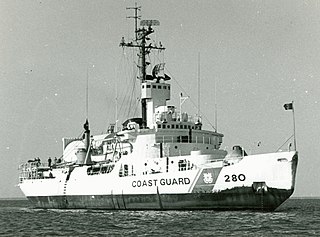
USCGC Southwind (WAGB-280) was a Wind-class icebreaker that served in the United States Coast Guard as USCGC Southwind (WAG-280), the Soviet Navy as the Admiral Makarov, the United States Navy as USS Atka (AGB-3) and again in the U.S. Coast Guard as USCGC Southwind (WAGB-280).
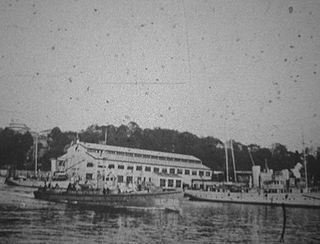
USS SC-22, during her service life known as USS Submarine Chaser No. 22 or USS S.C. 22, was an SC-1-class submarine chaser built for the United States Navy during World War I. She later served in the United States Coast Guard as USCGC Quigley.
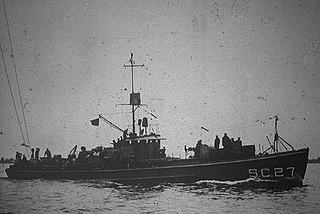
USS SC-27, during her service life known as USS Submarine Chaser No. 27 or USS S.C. 27, was an SC-1-class submarine chaser built for the United States Navy during World War I. She later served in the United States Coast Guard as USCGC Richards.












